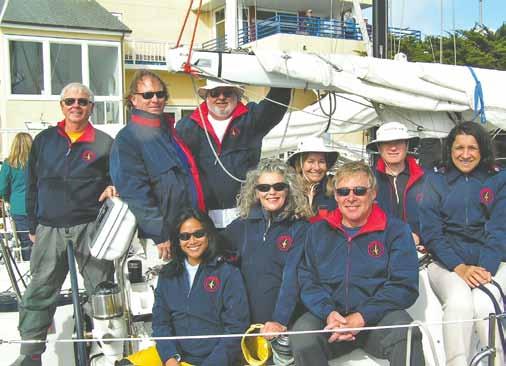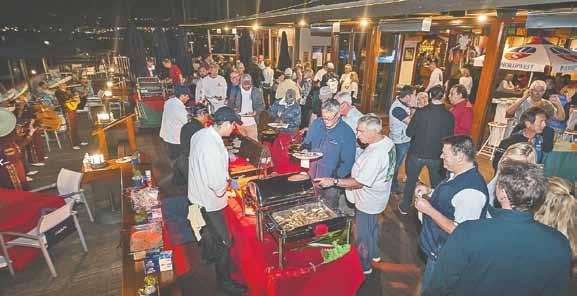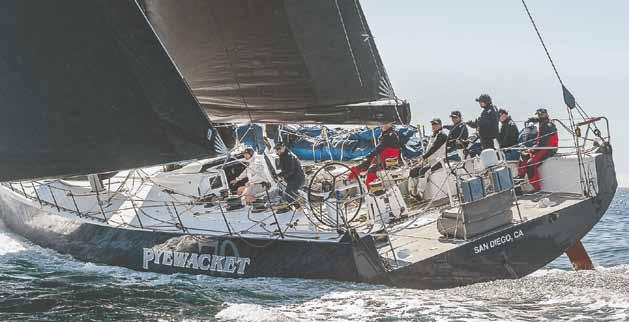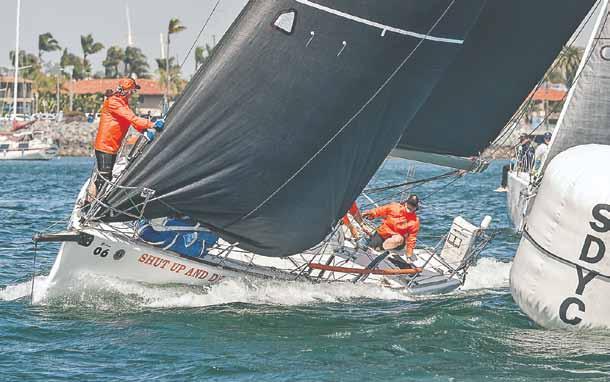
10 minute read
islander 36 at 50
Francisco Bay. Kit Wiegman has sailed many offshore races, including winning the Drake's Bay Race (OYRA), Half Moon Bay Race (SSS), Doublehanded Farallones (BAMA), and the ZYC Challenge singlehanded Lightship race. He raced in the Pacifi c Cup to Hawaii aboard his I-36 Cassiopeia in 2006, 2012 (second place in class) and 2016 (third place in class). In all of these, Cassiopeia was the slowest-rated boat in her division.
In 2014 Steve Hodges won the Singlehanded Transpacifi c race from San Francisco Bay to Hanalei Bay, Kauai, with his I-36 Frolic. Steve won the Hanalei Yacht Club Trophy as the overall winner, and also won the Jim Tallet Memorial Trophy for fi rst on corrected time on a yacht from outside Northern California (Frolic hails from Santa Barbara), and the Displacement Monohull Trophy for fi rst on elapsed time in a heavier monohull.
Advertisement
The I-36 is also a great family boat. "We purchased Pilot in the spring of 1990 and started racing her in 1992," refl ects Jim Robinson. "We bought her from a family in Morro Bay that had kids the same ages as ours at the time, which was 2 and 4. They were selling her because they thought it was too dangerous to have kids aboard. We were buying her because we believed it to be one of the safest boats around to raise kids on. Molly and Woody crewed for us until they went off to college. "I remember how open and welcoming everyone was. Don Schumacher, Rick Van Mell, Steve Schneider all reached out and answered any question Martha and I had about how to race and rig the boat. We didn't have a clue how to race it. The racing and cruising fl eet were, and continue to be, unbelievably inclusive and supportive. Steve was winning everything." Steve Schneider raced Absolute out of the Corinthian YC. "He could go to weather 5 degrees higher than almost everyone. He told me years later it was because he used a smaller jib — who would have thought, right? "The fi rst few years we fi nished so far behind the fl eet that we had no idea who was coming in fi rst. We knew for certain who was last! By the end of our run of winning I remember one race in the Berkeley Circle where we misread the race instructions and sailed the wrong course. The entire fl eet except for the last couple of boats followed us. All were disqualifi ed except those last two boats."
Pilot went on to win the Hammond Non-Spinnaker Trophy seven years in a row from 1994 through 2000. "When we were racing hard, it was almost always Tom Cat with Barry Stompe along with the green boat Tenacious and Windwalker that were always around us. Once Peter Szasz showed up with Midnight Sun we were toast. Peter was a wizard and that boat was just too quick to keep up with. I think we were getting 8 to 12 boats on the line on a regular basis, and the fl eet was very competitive."
Daphne Jackson's Nimbus (Daphne married Mike Dickson, who crewed for her) and Tim Shea's Lean Times fought for the "Smack Cup" for trash-talking each other and trying to stay out of last place. Peter Szasz started up race clinics in 2004.
Always looking to promote the I-36, 2004 commodore Harry Farrell encouraged sailing scribe Kimball Livingston to give the fl eet more publicity. Kimball's tart reply was, "Show me the bacon." With help from Harry's wife Carol Williams and Carol's daughter Michele Williams (who became the fi rst female I-36 commodore in 2010), I-36ers responded in force, with 21 represented.
In 2005, Kimball noted, "On San Francisco Bay, the Islander 36 fleet 'de-turboed' in order to get more boats out racing. The racing fl eet dwindled as people with the skill sets to handle spinnakers in a big breeze moved on to newer, hotter boats. Eliminating spinnakers and big jibs was a shot in the arm for the fl eet last year. Twenty boats turned out for the 2004 season opener, the Vallejo Race, making Islander 36s the biggest one design fl eet in the event."
In 2003 we added a Nationals Regatta at the end of the season. It was not counted as part of the season championship, but an event to get out the dedicated racer, the occasional racer, and even the cruiser who wanted to try racing. Sailed most years from Golden Gate YC, the Nationals carried no entry fees. With just Islanders out racing, there were no crowds of boats. The regatta is topped off with a celebration buffet at GGYC, where sea stories can be told and crews can mingle. The regatta has proved to be very popular, and continues to date. — rick van mell
The 2008 Nationals 'Freedom Won' crew at GGYC. Sign of the times: 2004's Vallejo Race raft-up.

Readers — We'll have Part 2 of this story, about cruising the Islander 36, in an upcoming issue of Latitude 38. In the meantime, check out the vast wealth of resources at www.islander36.org. — ed.

Every two years the opportunity to race a pair of extraordinary events in Mexico comes along. This is the San Diego to Puerto Vallarta Race (aka SD2PV) followed by MexORC, or Mexican Ocean Racing Circuit. Together they are similar to doing half of a Transpac followed by a Kenwood Cup (remember those?). But at the fi nish you will fi nd margaritas instead of mai tais.
PV Race
The reliably strong spring breeze along the west coast of Baja is why March is Mexico race time. Fortunately, there are many other reasons for racing the biennial San Diego to Puerto Vallarta Race, because this year's running — its 34th since 1953 — saw much of the fl eet taking nearly twice as long to cover the 1,000-mile course as the 3-day 5-hour record set by Manouch Moshayedi's Rio100 in 2016.
This year's fl eet comprised 29 boats in six Ocean Racing Rule (ORR) classes that started over three days beginning on March 5.
Light winds reward light boats, so it is no surprise that Bill Hardesty and his all-star crew aboard the relatively tiny Hobie 33 Sizzle led the pack down the Baja Peninsula, holding onto their Day 1 start position in the fl eet.
Strategies for the middle part of the race included 'banging the beach' with an inside track, the rhumb line approach for fewer miles sailed in the variable conditions, and outside in the search for more pressure. Daniel Gribble's Tripp 56 Brigadoon and J/World's DK46 Cazan defi ned the outside approach, leaving Cedros Island more than 100 miles of room. David Gates, watch captain aboard Cazan, reported being painfully on the J1 or jib top for more than half of the leg to Cabo.
At two thirds of the way down the track, the next hurdle becomes how to
The PV Race kickoff party in San Diego. 'Pyewacket 70' at their start on March 7.
play the Cone Zone, the wind shadow of Cabo San Lucas. This is where Roy Disney's new-to-him Pyewacket (exBlack Jack, a Volvo Ocean 70) fi nally passed fl eet leader Sizzle and led the way across the Gulf of California to mainland Mexico. Steve Meheen's Botin 80 Cabrón closed up their 40-mile defi cit to Pyewacket. In the midnight moonlight off Punta Mita the two boats were having such a focused light-air match race that both boats narrowly missed the fi nish line and had to return to sail through it, with Cabrón taking line honors.
Pyewacket corrected out for the ORR Class 1 win, with Erik Brockman's appropriately-named Volvo 65 Viva Mexico taking second in class.
Bill Hardesty's Sizzle, with crew Chuck Eaton, Tom Holthus and Parker Mitchell, claimed the overall win. The boat could be seen trailer-ready very shortly thereafter and was probably soon fl ying upwind through Sinaloa. Well done! In this slow year, at least one participant was still on the race course at awards time, making use of the no-time-limit rule. Others chose to visit Cabo for some fuel or maybe a fl ight home. Many boats finished with just enough time to clear customs/immigration and shower before the prize-giving. In the case of J/World's Cazan, the full MexORC crew was waiting dockside to turn their ocean racer into a buoy

ALL PHOTOS COURTESY THE PV RACE EXCEPT AS NOTED
machine. They even went out for a practice sail that afternoon. Skipper Wayne Zittel calmly said, "Yeah, it will be a quick turn."
MexORC
MexORC is legendary not only for its grand-prix racing around courses set inside beautiful Banderas Bay, but for the excellent shoreside management, entertainment and parties. They say there is a reason why the racing doesn't start until 1:30, and it isn't entirely due to the wind! This year was dubbed the Grand Finale because longtime MexORC organizer and president of the Mexican Sailing Federation Ernesto Amtmann Aguilar is retiring from running the event, presumably to spend more time with his new boat under construction in Europe.
Unfortunately, the COVID-19 pandemic impacted the big parties, and they were eventually canceled. The racing, however, was superb, with seven races over fi ve days.
The first item for the Saturday, March 14, beginning of the regatta was a ceremonial start between the first Whitbread Ocean Race winner, Mexico's Sayula II, and next year's The Ocean Race entry Viva Mexico (a VOR65, ex-Scallywag). It was a showcase example of how far yacht design has come in 47 years. And it was beautiful to see them cross tacks in front of Our Lady of Guadalupe Church with its iconic crown modeled after Queen Carlota's circa 1864.
Soon thereafter began the spectatorfriendly Copa Puerto Vallarta Race along the city's malecon for two laps, followed by a long beat to the Nayarit/Jalisco state line, with a downwind fi nish led by Doug Baker's Kernan 68 Peligroso. This would be a common theme for the regatta. The 68-footer is a well-sailed Mexi-Machine that knows and loves Banderas Bay. The result was straight bullets for the regatta.
Days 2 through 5 were like a Mexican Groundhog Day. Wake up, go to the boat, rig with your friends, and motor out into the perfect conditions for sailing, where you try not to be distracted by spectacu-
Nathalie Criou's San Francisco-based Figaro 2 'Envolée' at the start in San Diego.
BILL HARDESTY

Bill Hardesty and the lads sizzled their way down the coast to an overall win.
lar whale sightings.
In addition to Peligroso, class A included a pair of J/145s and a J/125, a Ker 51, DK46, SNC50, Soto 40 and a Swan 42. Tough fl eet!
Class B included the venerable Capri 37s, a Varianta 44, a Frers 43, a 1D35 and a Beneteau 36.7. This fl eet was more than half Mexican-fl agged vessels, with one Canadian and the rest from the US. Rounding out the fl eet was Class C, comprising four Farr 40s that regularly dry-sail out of Acapulco. It's encouraging to see so much Mexican participation in yacht racing, and also how many women sailors there are. One boat (a 40-footer, mind you, going around the buoys) only had two guys on board, neither of whom was skipper or navigator. Buen trabajo, Mexico. This was the 44th running of the regatta that emerged as an initiative by a group of Mexican sailors interested in preserving the tradition of the San Diego to Acapulco Regatta. Whatever becomes of MexORC going forward, the Grand Finale version of 2020 will be remembered for the sailing's being so good that it made up for the muted parties the event is known for. And, back to its feeder race,








